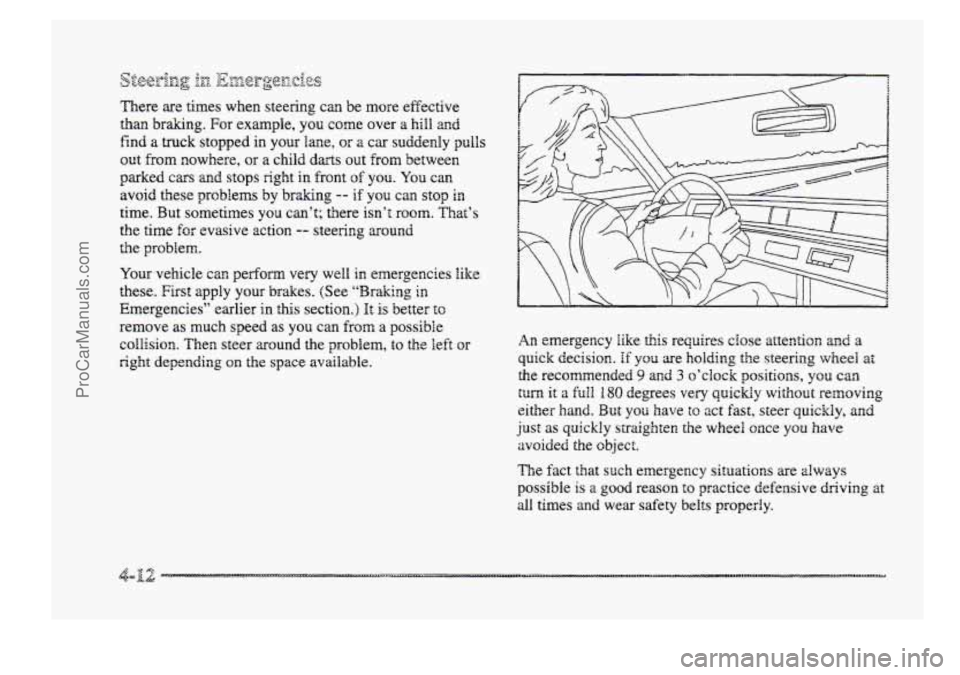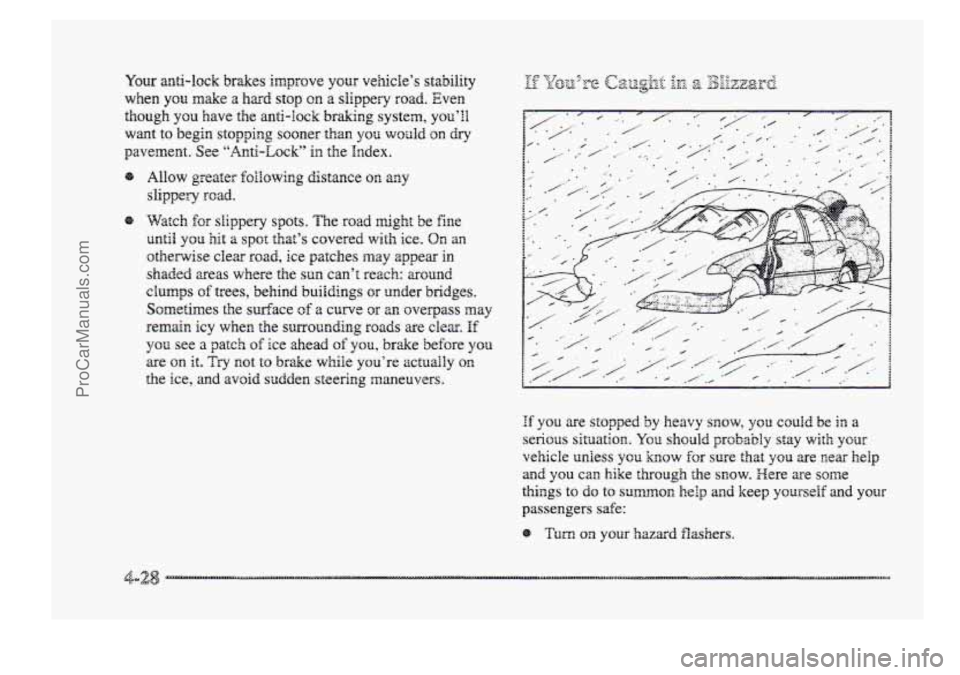Page 152 of 426
A I'iw is Mowr~, Sce "'%;USC:S and Circuit Breakers" in
the Index.
Keep in mind that yorrr wincishield is part of the WUD
system. If you ever have to have your windshield
replaced,
be sure to get one that is designed for WUD OF
your HUD image may look bhrred or out of focus.
Ymr vehicle may be equipped with a Driver
Infolmntionz Center (DIC). The DIC will display
information about how
your vehicle is functioning, as
well as warning messages if a system pr~b'ee~~~
is deteczed.
The fobwing buttons are
on the DIC control panel
which
is located to the left
of the steering column:
0 ODO/TRfB: Use this button to display your total and
trip miles.
ProCarManuals.com
Page 165 of 426
In this section, you'll find out how to operate the comfort control and audio systems cffered with your whicle. Be
sure to read about the particular systems supplied with your vehicle.
3-2
3-2
3-2
3-5
3-5
3 -6
3-7
3-8
3-8
3-9
3 -9
3- BO
3-10
C~mf~r;t Cr>n:rols 5 3-14
Personal
Choice Comfort ControIs
(If Equipped) 3-18
Dud Automatic CornforTernp Clirnate Control !
Air Conditioning 3-21
Heating $
VentiEation System
Passenger Compartment
Ais Filter [ 3-27
Defogging and Defr'rosting ; 3-30
Wear Window Defogger
: : 3-30
Passenger Climate Control : 3-33
Steering Wheel Controls
fcr Climate Controi 3-34
(If Equipped) :. 3-34
Setting
the Cbck i 3-35
AM-FM Stereo with Cassette Tape Player 9 3-36
(.If Equipped) 3-36
::
::
::
ProCarManuals.com
Page 197 of 426
To unlock a secured radio see ‘6Udock.ing the
Thefi-Deterrent Feature After
a Bower LOSS” earlier in
this section.
Audio Steering W3eel c@ntr@ls
If your vehicle has this feature, can control certain
radio functions using the buttons on your steering wheel.
Some steering wheel controls may operate climate
CO~&Q~S. See “’Steering Wheel Controls for Climate
Contd” earlier in
this section.
button
to SEEK: Press this
go to the next higher or
lower radio station.
SCAN: Press this button to scan the stations preset on
your radio psaslnbuttons. This feature works like your
radio’s P SCAN button and allows YOU to listen to each
of you preset stations for a few seconds. The radio will
go to the fist preset station, stop for a few seconds, then
go on to the next preset station. Press SCAN again to
stop scanning.
If a preset station has weak reception, the
radio will mot stop at the preset st&hn~.
ProCarManuals.com
Page 207 of 426
YO:; have three systems that make YQLX vehick go wircre
you want it to go. They are the brakes, the steering anti
the accelerator. AH three systems have to do their work
at the places where the tires meet the road.
ProCarManuals.com
Page 212 of 426
To turn the system off, press the button l~cated at the
end of the shift lever.
The traction control system warning light will come on
and stay on. If the system is limiting wheel spin when
you press the button, the warning light will come
on -- but the system won’t turn off right away.
It will wait until there’s no longer a current need to hit
wheel spin.
Ym can turn the system back on at any time by pressing
?.he button again. The traction control system warning
Bi& xkcPetM go off.
Your vehicle may be equipped with GM Magnasteer ” ,
a steering system that continuousIy adjusts the effort you
feel when steering at all vehicle speeds. It provides ease
when parking yet a firm, solid feel at highway speeds.
You- steering can be adjusted for an easier or more firm
setting. See your dealer for information
ProCarManuals.com
Page 213 of 426
It‘s important to take curves at ;r reasonable speed.
A lot of the “driver lost control” accidents mentioned on
the news happen on curves. Here’s why:
Experienced driver or beginner, each of us is subject to
the same laws of physics when driving on curves. The
traction of the tires agzjinst the roaC surface makes it
possible fcr the vehicle to change its path when you turn
the front wheels. If there’s no traction, inertia wiHl keep
the vehicle going in
the same direction. If you‘ve ever
tried
to steer a vehicle on wet ice, YQK‘IB understacd this.
The
trzctionr YOU can get in a curve depends on the
condition of your tires md the road surface, the angle at
which Gie curve
is banked, and your speed. Mile you’re
in ip curve, speed is the one fxtor you can control.
Suppose ycu’re steering through a sharp curve.
Then you suddenly accelerate. Both control
ProCarManuals.com
Page 214 of 426

&3g;-izg 1x1 0 &i&rpe[z.iQs 7,ww e?
There are times when steering can be more effective
than brakmg. For example, you come over a hill and
find a truck stopped in your lane, or a car suddenly pulls
out from nowhere, OH a child darts out from between
parked
cars md stops right in front of YOU. You can
avoid these problems by
braking -- if you can stop in
time. But sometimes you can’t; trlere isn’t room. That’s
the time
for evasive action -- steering ~ound
the problem.
Your vehicle can perform very well in emergencies like
these. First apply your brakes. (See ‘‘Braking in
Emergencies” earlier in ”s section.) It is better tc
remove as much speed as you can from a possible
collision. Then steer around the problem, to the left or
right depending on the space available.
An emergency like this requires close attention and a
quick decision. If you are holding the steering wheel a’:
the recomended 9 and 3 o’clock positloas, you can
tuna it a full 180 degrees very quickly without removing
either hand. But you have to act fast, steer quickly, and
just as quickly straighten the wheel once you have
avoided the
object.
The fact that such emergency situations are always
possible is a good reason to practice defensive driving at
dl times and wear safety belts properly.
ProCarManuals.com
Page 230 of 426

Your anti-lock brakes irr;.lp~~e your vehicle’s stability
when
you make a hard stop on a slippery road. Even
though
you have the anti-lock braking system, p~’i8
want to begin stopping sooner than you would on dry
pavement. See “Anti-Lock)’ in the Index.
@ Allow greater following distance on a~y
@ Watch for slippery spots. The road might be he
until
you hit a spot that’s covered with ice. Ora an
otherwise clew road, ice patches may appear in
shaded areas where the sun can’t reach: around
clumps of trees, behind buildings or under bridges.
Sometimes the surface
of a curve or an overpass may
remain icy when the surrounding roads are cka. ff
you see a patch of ice ahead of you, br&e before you
are on it. Try not to br&e while you’re actually on
the ice, and avoid sudden steering maneuvers.
slippery
road.
If you are stopped by
heavy snow, you couId be in a
serious situation. YOE skhoald prsbably stay witk your
vehicle unless
you know for sure that you are zear help
and you cas hike through the snow. Here are some
things to do to SUH~~QEZ kip and keep yourself and ~QUI-
passengers safe:
@ Turn on your hazard flashers.
ProCarManuals.com